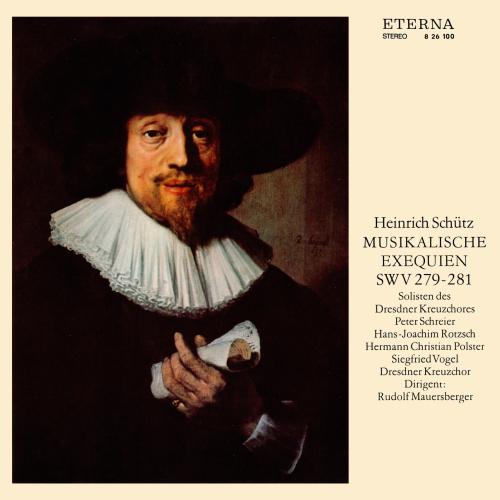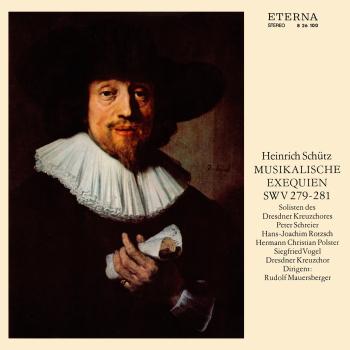
Schütz: Musikalische Exequien (Remastered) Dresdner Kreuzchor & Rudolf Mauersberger
Album info
Album-Release:
1970
HRA-Release:
01.11.2024
Label: Eterna
Genre: Classical
Subgenre: Vocal
Artist: Dresdner Kreuzchor & Rudolf Mauersberger
Composer: Heinrich Schütz (1585-1672)
Album including Album cover
- Heinrich Schütz (1585 - 1672): Musikalische Exequien:
- 1 Schütz: Musikalische Exequien: Concert in Form einer teutschen Begräbnis-Missa, SWV 279 (Remastered) 27:34
- 2 Schütz: Musikalische Exequien: Motette "Herr, wenn ich nur dich habe", SWV 280 (Remastered) 03:15
- 3 Schütz: Musikalische Exequien: Canticum B. Simeonis "Herr, nun lässest du deinen Diener in Frieden fahren", SWV 281 (Remastered) 04:49
Info for Schütz: Musikalische Exequien (Remastered)
The Exequien were written for the burial service of Prince Heinrich Posthumus von Reuss, a nobleman whom Schütz had probably counted as a friend from 1616 or 1617. Although the music was commissioned by Posthumus’ widow and sons after his death in December of 1635, it had been planned in some detail by Heinrich Posthumus himself well before his death. His will specifies the texts to be set and the character of the music to be used in setting them, as well as the decorations on his coffin and the positioning of the attendants and participants in the service.
Such a degree of concern with the formal presentation of one’s own death may strike us as odd, maybe a trifle obsessive. It can be hard for us, creatures of an age in which death is generally treated as an inexplicable dispersal of meaning, a kind of obscenity, to fathom the importance it held to a 17th-century Lutheran mind. Death was an answer, a resolution, a reward. Peace could finally arrive with death. It was the central event of a righteous life—clearly, personally, and achingly longed for.
Death was also everywhere, inescapable. Schütz, in his long life, had the dubious honor of bearing witness to the entire course of the Thirty Years’ War, surely one of the most devastating conflicts Europe has ever undergone, arguably as grievous, in its effect upon ordinary citizens, as anything living memory has produced. Like the First World War, the Thirty Years’ War coincided with epidemics—influenza in the former case, plague in the latter—that probably killed as many people as the fighting. Substantial parts of Northern Europe were, literally, reduced to a tenth of their former population. Schütz himself lost his young wife in 1625, and had endured the deaths of all his daughters by 1655. In this context of general chaos and desolation, Heinrich Posthumus’ meticulous concern with an orderly, harmonious, and meaningful presentation of death is doubly understandable.
Peter Schreier, tenor
Werner Jaroslawski, tenor, viola da gamba
Hans Otto, organ
Dresdner Kreuzchor
Rudolf Mauersberger, conductor
Digitally remastered
The Dresden Kreuzchor
is one of the world’s oldest and most famous boys’ choirs. Its most important task 800 years later is still the musical accompaniment of the vespers and services at Dresden’s Kreuzkirche. Not only on religious holidays but also throughout the whole church year, the Kreuzchor accompanies half of all liturgical services in the famous church at the old market.
The impressive architecture of the Kreuzkirche is an added attraction for the 3000 spectators of its choir concerts. As the city’s oldest and critically acclaimed cultural institution, the Dresden Kreuzchor has marked Dresden’s musical life in a very special way and spreads the city’s reputation as a cultural metropolis throughout the world as one of its most prominent ambassadors.
Several times a year, the Dresden Kreuzchor goes on national and international concert tours, beyond German and European borders to Israel, Canada, Japan, South America and the USA. More-over, it performs at international music festivals as well as countless radio and television recordings. A very wide repertoire ranging from early Baroque to world premieres of contemporary music has enabled it to make more than 800 recordings in the last 80 years for prestigious record labels such as Deutsche Grammophon, Teldec, Capriccio and Berlin Classics. There is a constant cooperation with famous orchestras such as the Dresden Philharmonic and the Sächsische Staatskapelle Dresden. Renowned opera houses regularly employ choir soloists for solo parts such as the three boys in the Magic Flute.
The Kreuzchor singers, called “Kruzianer”, still graduate at the Kreuzschule; about half of them live in the adjacent boarding school. Next to their normal classes, the 130 singers aged nine to eighteen have weekly singing and instrumental lessons. Their daily rehearsals and the specific sound of the choir are the basis of the success and the fame of the Dresden Kreuzchor.
This album contains no booklet.












